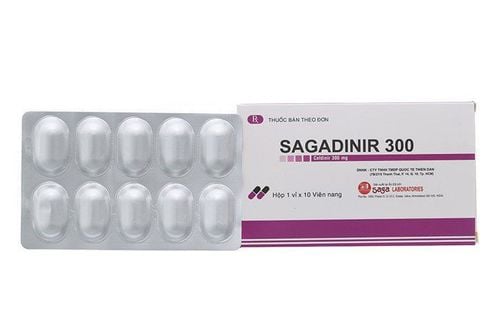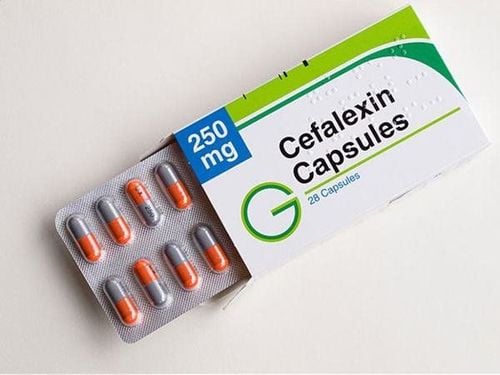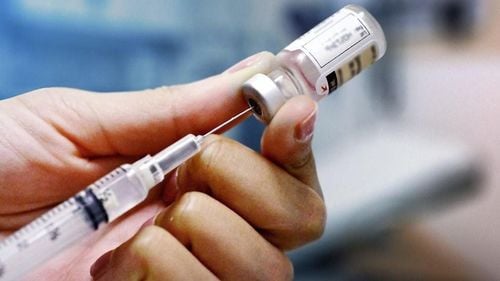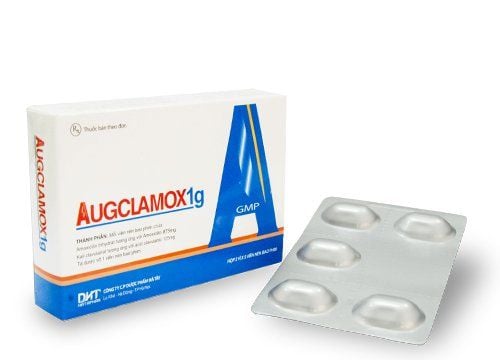This is an automatically translated article.
Dophasidic drug is prepared in the form of an oral suspension, with the main ingredient being nalidixic acid. The drug is used in the treatment of certain urinary tract infections. Please refer to the article below for more useful information about this drug.
1. What is Dophasidic?
Each vial of Dophasidic 100ml contains 6g of nalidixic acid and other excipients. Nalidixic acid is a synthetic antibiotic belonging to the Quinolone group, with a broad antibacterial spectrum, mainly active against gram-negative aerobic bacteria. The antibacterial mechanism of nalidixic acid is to inhibit the activity of the DNA gyrase enzyme in the DNA replication process at the late stage of bacteria, helping to kill bacteria effectively.
Nalidixic acid does not affect intestinal anaerobic bacteria, so it helps to balance the intestinal microflora. Currently, nalidixic acid is commonly used to treat urinary tract infections because the majority of acute and chronic urinary tract infections are caused by gram-negative intestinal bacteria.
Indications for use of Dophasidic drug in the following cases:
Treatment of uncomplicated lower urinary tract gram-negative infections, caused by bacterial strains such as E.coli, Klebsiella sp., Enterobacter sp., Proteus sp. ., except Pseudomonas; Because nalidixic acid is associated with serious adverse reactions, and uncomplicated urinary tract infections in some patients resolve spontaneously, dophasidic should only be used in patients with no treatment options. other replacement. Dophasidic drugs are not allowed to be prescribed in the following cases:
Patients with hypersensitivity to nalidixic acid or drugs of the quinolone group; Patients with severe renal failure; Patients with G6PD enzyme deficiency, history of seizures, convulsions, central nervous system disorders, cerebral vascular occlusion; Children under 3 months old; Patients who are being treated with chemotherapy for spinal cancer (such as melphalan because it can cause ulcerative colitis, bleeding or necrosis of the intestine).
2. Dosage and administration of Dophasidic
Dophasidic drugs are used orally, can be taken before or after meals, preferably 1 hour before meals. Patients should shake the vial well before taking the drug, do not use it with antacid drugs.
Dosage:
Adults: Take 1g each time (equivalent to 17ml of suspension) x 4 times/day, at least 7 days apart. If the treatment period lasts 14 days, the dose should be reduced by 1⁄2 to 0.5g/time (equivalent to 8.5ml of suspension) x 4 times/day at equal intervals. Although the antibacterial effect of nalidixic acid is not affected by urine pH, concomitant use with sodium citrate or sodium bicarbonate may increase the concentration of the active drug in the urine. Therefore, when combining nalidixic acid and sodium citrate, the adult dose is 660mg/time (equivalent to about 11ml suspension) x 3 times/day, for 3 days; Children 3 months - 12 years: Use a dose of 55 - 60mg/kg/day (equivalent to about 1ml of suspension/kg/day) 4 times at equal intervals. If treatment is prolonged, the dose should be reduced to 30-33mg/kg/day (equivalent to about 0.5mg suspension/kg/day) x 4 times/day. Duration of taking the drug lasts for 7-14 days; Patients with renal impairment: It is necessary to calculate the appropriate dose for patients with creatinine clearance below 20ml/min. Below this threshold, a dose equal to 1⁄2 of the usual dose should be used. Dophasidic drugs are susceptible to drug resistance, so it is necessary to change the drug if there is no effect on the patient's urine after 48 hours through evaluation from bacterial culture and bacterial susceptibility testing. Blood tests, liver and kidney function tests should be performed periodically if this drug is used continuously for more than 2 weeks. Overdose: When using Dophasidic drug overdose, patients may experience symptoms such as: Vomiting, hemolysis, diarrhea, increased intracranial pressure, seizures, lethargy, mental confusion. The patient needs to be gastric lavage, warm and ventilate fan. If the drug has been absorbed, intravenous fluids and supportive measures should be used, giving the patient oxygen and artificial respiration. In case the patient has a convulsion, Diazepam should be injected;
Missed dose: If you forget to take a dose of Dophasidic, you should take it as soon as you remember. If it is close to the time of your next dose, skip the missed dose and take your next dose as originally scheduled. No need to take a double dose.
3. Dophasidic side effects
Nalidixic acid (the main ingredient of the drug Dophasidic) is generally well tolerated, adverse reactions are usually mild. When using Dophasidic drug, patients may experience some side effects such as:
Common: Headache, nausea, vomiting, diarrhea, double vision, blurred vision, color vision not standard, skin reactions light poisoning (vesicles on exposure to the sun during or after treatment); Uncommon: Increased intracranial pressure (especially in young children), skin urticaria, skin pruritus; Rare: Confusion, nightmares, hallucinations, anaphylactic reactions, leukopenia, thrombocytopenia, eosinophilia, G60PD deficiency anemia, angioedema, arthralgia.
4. Be careful when using Dophasidic drug
Before and while taking Dophasidic, patients should note:
Dophasidic users should avoid exposure to sunlight or sources of ultraviolet rays; Dophasidic should be used with caution in patients with hemophilia because of the high plasma binding rate of nalidixic acid; Patients with liver failure, severe renal impairment (creatinine clearance less than 20ml/min) need to reduce the dose of the drug; When using Dophasidic for pregnant or lactating women, children under 18 years of age, the benefits and risks need to be weighed. The reason is that in testing, nalidixic acid was able to cause degeneration of joints that carry body weight (in immature animals). The drug should be discontinued if there is pain in the joints or peripheral nerve pain; Should check blood count, kidney function, liver function periodically when taking Dophasidic drug continuously for more than 2 weeks, especially in people with liver disease, cerebrovascular obstruction, epilepsy; If diarrhea is treated with nalidixic acid, the causative agent of which is Clostridium difficile, it can cause severe diarrhea or pseudomembranous enteritis. Because Clostridium difficile produces 2 toxins A and B that cause diarrhea. In this case, fluid and electrolyte replacement, vitamin supplementation, and alternative therapy should be selected for the patient; When using Dophasidic, patients may experience serious, potentially irreversible, and disabling adverse reactions (including tendonitis, tendon rupture, peripheral nerve disease, neurological side effects. central nervous system such as hallucinations, anxiety, insomnia, confusion, depression and severe headaches). The drug should be discontinued at the first sign of any serious reaction. In addition, avoid using the drug in patients who have experienced severe reactions related to fluoroquinolones; Nalidixic acid stimulates the central nervous system, causing dizziness, lightheadedness, phototoxicity (when exposed to sunlight), hallucinations, tremors. Therefore, it is best for patients not to drive or operate machinery while taking Dophasidic.
5. Dophasidic drug interactions
Some drug interactions of Dophasidic include:
When Dophasidic is used concurrently with the anticoagulant warfarin and its derivatives, it is necessary to monitor the patient's blood clotting time; Nalidixic acid increases the concentration of caffeine, theophylline, cyclosporin because the drug reduces caffeine clearance and prolongs the half-life of these substances if used concomitantly; Should use antacid drugs containing magnesium, aluminum, iron, calcium, copper, zinc, ... before or after 2 hours when taking Dophasidic; Probenecid reduces the urinary excretion of Dophasidic drug, leading to a decrease in the effectiveness of this drug in the treatment of urinary tract infections and at the same time an increase in systemic side effects; nalidixic acid is cross-resistant with quinolone derivatives such as cinoxacin and oxolinic acid; Nalidixic acid may be limited in effect if used concurrently with bacteriostatic antibiotics such as nitrofurantoin, chloramphenicol, tetracycline; Nalidixic acid alters the electrocardiogram, leading to prolongation of the QTc interval; Dophasidic should not be used for patients taking antiarrhythmic drugs such as amiodarone, procainamide; quinidine, sotalol. When using Dophasidic, patients should follow all indications and instructions of the doctor to ensure high therapeutic effect and avoid the risk of serious side effects.
Please dial HOTLINE for more information or register for an appointment HERE. Download MyVinmec app to make appointments faster and to manage your bookings easily.













